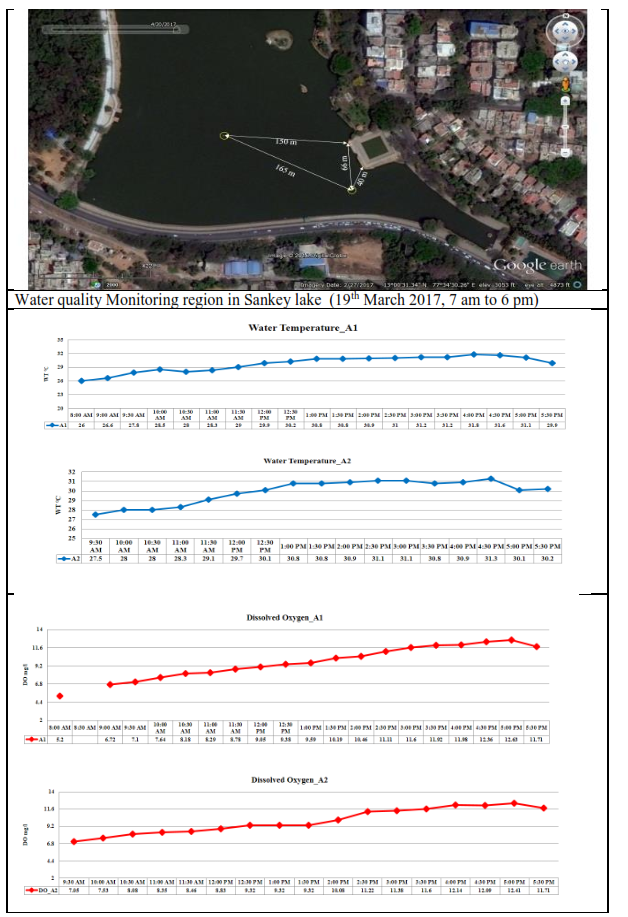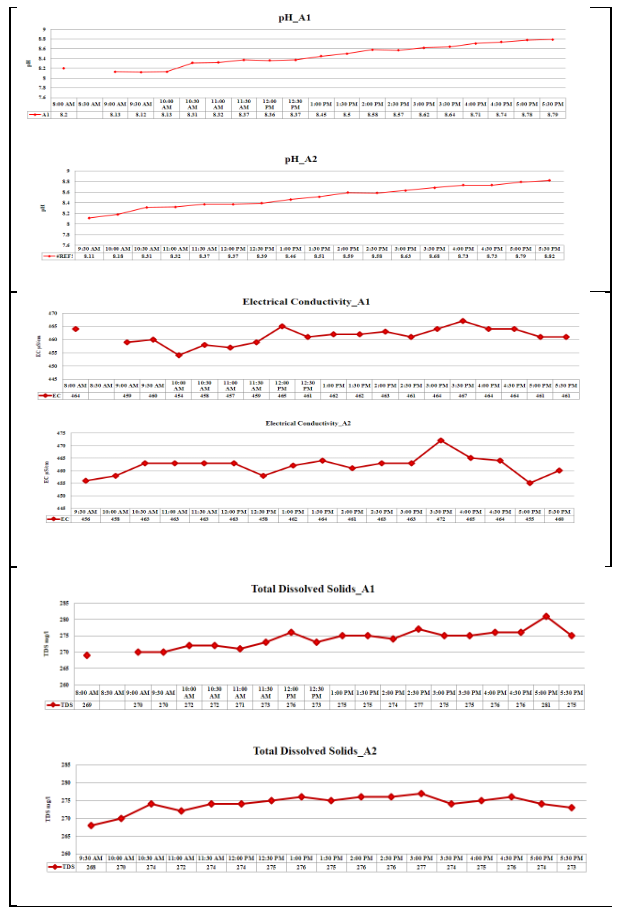|
|
| |
Annexure ii
: AERATORS Vs. FOUNTAINS
- The lake being shallow, micro bubble option of aeration (for the entire lake) is not viable.
- Micro bubble option fails on economic criteria due to the relative higher initial and regular maintenance cost compared to the proven indigenous technologies suitable for shallow lakes
- One of the serious impacts would be the habitat destruction of micro and macro benthos leading to instability and decline of fish spawning regions
- Remove macrophytes – regularly (till the nutrient inflow into the lake is checked / or treated sewage is let into the lake)
- remove all blockades at outlets – so that water will move leading to natural aeration
- install surface fountains, which enhances not only the aeration but also recreation value of the lake. Music fountains would aid in de-stressing as well as recreation
Surface Aeration v/s Bottom-up Aeration for Bellandur Lake
S No. |
Description |
Fountain (Surface Aeration) |
Bubble Aerator (Bottom Up Aeration) |
1 |
Oxygen transfer rate/efficiency |
Oxygen transfer upto 6 to 12”. |
10 times higher |
2 |
Cost |
Operating cost is high. |
relatively higher initial and regular maintenance cost |
3 |
Power Consumption |
Power requirement is higher |
less power when compared to surface aeration. |
4 |
Safety |
Requires insulation of cables |
Airline pipe can run to the air compressor which can be kept at some place isolated from water. |
5 |
Frothing |
No frothing |
Frothing is inherent. |
6 |
Clogging problem |
No problem of clogging. |
Clogging problem is inherent. System has a lifetime of 1-2 years. Biofilm may develop (clogging the filter). When this problem encounters, it starts consuming more energy. |
8 |
Suitability |
For shallow lakes |
For deeper lakes (Suitable to install at deeper points in our case). |
7 |
Miscellaneous |
a. Evaporation rates may increase.
b. prevents froth. |
Frequent cleaning is required. |
But in case of Bellandur Lake, the depth is not much and the water is always flowing so fountain system may work effectively at initial stage. Later it can be incorporated with the aerators as well depending on the condition and practicality.
Source:http://www.vertexwaterfeatures.com/sites/default/files/Vertex_Fountain_AerationJet_Specs_LED_110716.pdf
A fountain aerator can cover a diameter of ~40 feet (Figure 1), i.e., nearly 12 meters diameter, covering a surface area of 115 sq.m., for Bellandur lake considering various placement option at 50 m center to center to 250 m center to center, and considering scenarios of covering entire lake of 900 ac or portion of lake over 0.5m current water depth i.e., 551 ac is as shown in table 1.

Figure 1: Floating fountain and technical details
Table 1: various Scenarios for fountain placement
distance c/c in meters |
~900 acres |
Number of fountains [~551 acre (excluding 0.5 m depth regions – pre de-siltation/current depth)] |
150 |
165 |
75 |
200 |
95 |
40 |
250 |
60 |
25 |
East twin lake of Michigan of USA has an area of 900 acres. At the inlet of the lake eight Vertex Air 3 XL systems, i.e., about 24 diffusers with 8 aerators were used covering an area of 160 acres (Fig 2). Source: http://www.vertexwaterfeatures.com/sites/default/files/PDF-Case-Study-East-Twin-Lake-10y-Update-051016_0.pdf

Similar to Michigan Twin lake, Bellandur lake has an area over 900 acres (but sustained inflow of untreated sewage), if aerators area used to cover the entire area, about 45 aerators with 135 diffusers are necessary. Considering current conditions and a minimum depth of over 0.5 meters, area of lake is 551 acres, 28 aerator units with 84 diffusers would be necessary.
Proposed combination of Surface (Fountain) aerators and Deep (Diffused) aerators, where in the diffused aerators are placed at the inlets, and fountains at the centre as shown in Fig 4.
About 25 diffusers with 10 air flow systems at the inlets A, B, C and D and about 40 fountains at 200 m center to center would be necessary to cover the lake (Table 2).
Table 2: Number of aerators and fountain necessary to cover Bellandur lake
Aerators/Fountains
|
|
Area in Acres |
# of diffusers |
air flow system |
Diffused Aeration system* |
inlet A |
86 |
13.0 |
5.0 |
inlet B |
58 |
9.0 |
3.0 |
Inlet C |
3 |
1.0 |
1.0 |
Inlet D |
11 |
2.0 |
1.0 |
Fountain Aeration Systems |
Center |
393 |
Fountains 40.0 |
@ 200m center to center |
*Note: if sewage is treated through integrated wetlands system, diffused aeration system is not required.

Figure 4: Combined proposal of diffusers (not required after sewage treatment) and fountain aerators.
Fountains at Sankey Lake - Advantages of Aeration: Improvements in dissolved oxygen (refer details provided next) and aesthetic beauty and enhanced recreation value is observed after installation of fountains. Even algae such as Microcystis infestation has reduced considerably after installing fountains in the lake.



|
T.V. Ramachandra
Centre for Sustainable Technologies, Centre for infrastructure, Sustainable Transportation and Urban Planning (CiSTUP), Energy & Wetlands Research Group, Centre for Ecological Sciences, Indian Institute of Science, Bangalore – 560 012, INDIA.
E-mail : cestvr@ces.iisc.ernet.in
Tel: 91-080-22933099/23600985,
Fax: 91-080-23601428/23600085
Web: http://ces.iisc.ernet.in/energy
Durga Madhab Mahapatra
Energy & Wetlands Research Group, Centre for Ecological Sciences, Indian Institute of Science, Bangalore – 560 012, INDIA.
E-mail: durgamadhab@ces.iisc.ernet.in
Vinay S
Energy & Wetlands Research Group, Centre for Ecological Sciences, Indian Institute of Science, Bangalore – 560 012, INDIA.
E-mail: vinay@ces.iisc.ernet.in
Sincy V
Energy & Wetlands Research Group, Centre for Ecological Sciences, Indian Institute of Science, Bangalore – 560 012, INDIA.
E-mail: sincy@ces.iisc.ernet.in
Asulabha K S
Energy & Wetlands Research Group, Centre for Ecological Sciences, Indian Institute of Science, Bangalore – 560 012, INDIA.
E-mail: asulabha@ces.iisc.ernet.in
Sudarshan P. Bhat
Energy & Wetlands Research Group, Centre for Ecological Sciences, Indian Institute of Science, Bangalore – 560 012, INDIA.
E-mail: sudarshan@ces.iisc.ernet.in
Bharath H. Aithal
Energy & Wetlands Research Group, Centre for Ecological Sciences, Indian Institute of Science, Bangalore – 560 012, INDIA.
E-mail: bharath@ces.iisc.ernet.in
Citation: Ramachandra T V, Durga Madhab Mahapatra, Vinay S, Sincy V, Asulabha K S, Sudarshan Bhat, Bharath H. Aithal, 2017. Bellandur and Varthur Lakes Rejuvenation Blueprint, ENVIS Technical Report 116, Environmental Information System, CES, Indian Institute of Science, Bangalore 560012.
|







